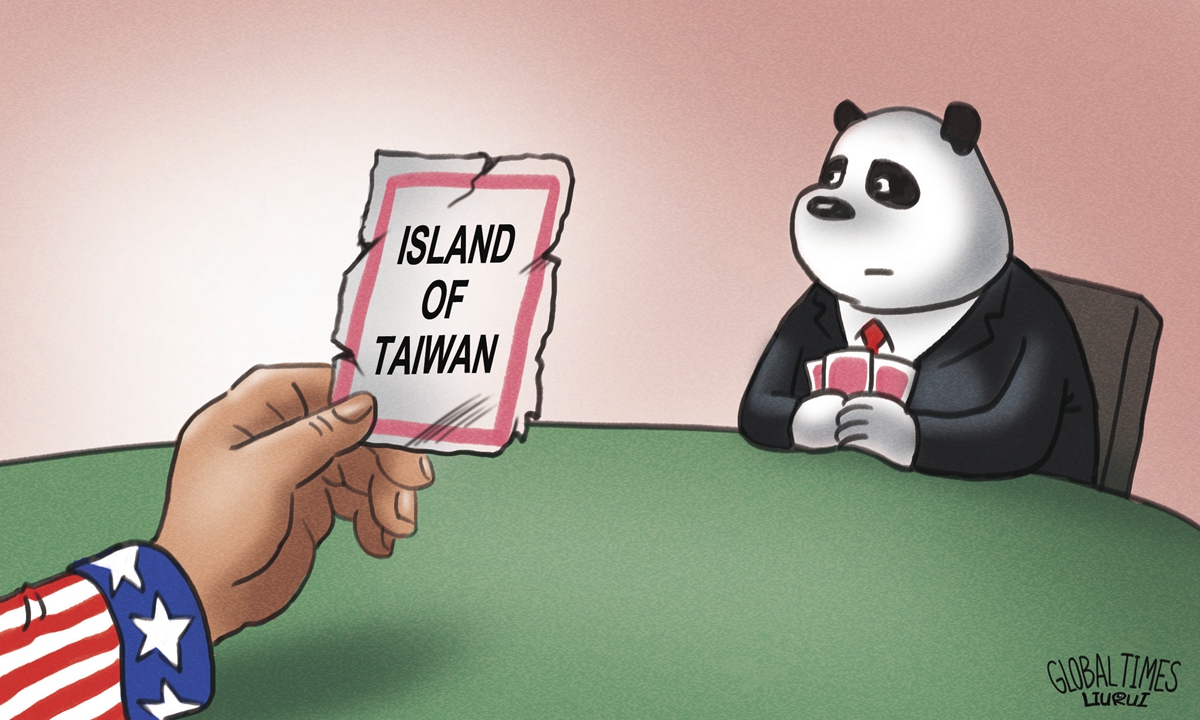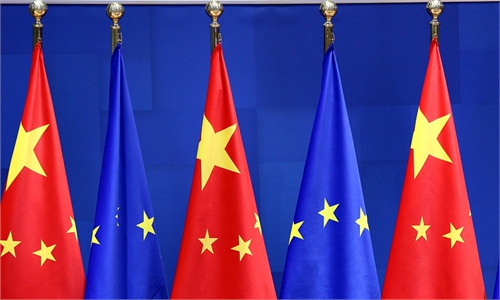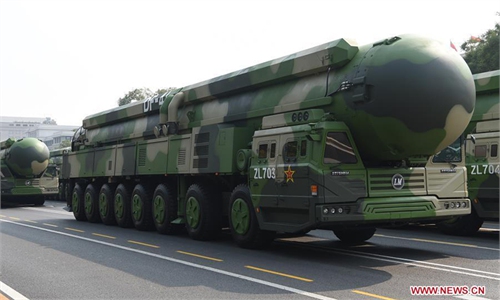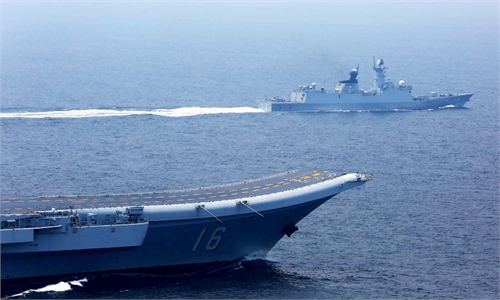
US, China, Taiwan island Illustration: Liu Rui/GT
The relationship of the People's Republic of China to the United States enjoyed a glorious beginning and a promising friendship. It began when President Richard Nixon recognized the importance of rising China to the international order. His vision was not limited to China's value in Cold War realpolitik but extended to the horizon of an uncertain future. 50 years later President Nixon's foresight has been replaced by reactionary American parochialism, with Taiwan island in the eye of a storm that is leading to an apocalyptic confrontation. A brief history can clarify what went wrong.In 1949 the Republic of China (ROC) was exiled to Taiwan island pausing China's civil war. As our ideologically aligned Chinese ally we stood by the ROC in anticipation of the nationalists someday defeating and replacing the newly founded PRC. The dispute was a contest for rulership of all One China. The nationalist ROC was intent on reunifying the mainland with the island under a Western governance model and eradicating communism. At the time the ROC occupied the United Nations (UN) China seat, and in 1955 the US and ROC entered the Sino-American Mutual Defense Treaty, stationing American forces aboard Taiwan island.
But in 1971 the UN voted to eject the ROC from the China seat that it was filling and welcomed the PRC to fill the China seat as the only legitimate government of China. The UN has never recognized the ROC or Taiwan island as anything other than a politically alienated Chinese population aboard China's sovereign territory. The US is a signatory to the UN Charter. President Nixon and his advisor Dr. Henry Kissinger recognized the new global realities and commenced the US' outreach to the PRC, which culminated in the President's historic visit with Mao Zedong in the PRC.
Three Joint Communiqués later emerged from ensuing bilateral negotiations between the US and China. The wording and specific interpretation of each was agreed upon by the US and PRC in good faith in advance of each publication. They are cherished by the Chinese as the authoritative foundations of our countries' diplomatic relations.
The 1st Joint Communiqué was published in 1972 during the Nixon Presidency. The Chinese reaffirmed that the Taiwan question is the crucial question obstructing the normalization of relations between China and the US, that the PRC is the sole legitimate government of China and Taiwan is a Province of China, and that the ROC, the island territory and reunification were China's internal affair. The US acknowledged that all Chinese on either side of the Taiwan Strait maintain there is only One China and Taiwan is part of China. The US also reaffirmed its interest in a peaceful settlement of the Taiwan question by the Chinese themselves and agreed to remove all U.S. forces from the island. Finally, both nations pledged not seek hegemony in the region or enter into agreements with other states in order to establish hegemony.
The 2nd Joint Communiqué was negotiated and published in 1978 during the Carter Presidency. In it the PRC and the US agreed to establish formal diplomatic relations. The US again acknowledged the Chinese position that there is only one China and Taiwan is part of China, and also affirmed the PRC is the legitimate government of China. The US agreed to limit its ROC affiliation to informal cultural and commercial relations. Both countries revalidated the 1st Joint Communiqué. Concurrently, the President rescinded the Sino-American Mutual Defense Treaty with the ROC.
But the China lobby in the US was determined to tie the US to the ROC's fate. The US Senate challenged the President's unilateral actions, however, the Supreme Court upheld them. Dissatisfied with the ruling, both houses of Congress passed the Taiwan Relations Act (TRA). As a public law the TRA directed weapons sales to the ROC for self-defense and maintenance of a US capacity to militarily intervene in the island's defense. Although the TRA torpedoed the intent of the 1972 and 1978 communiqués, President Carter signed it into law in 1979.
One China sovereignty and territorial integrity were not immediately jeopardized since the aims of the ROC and the PRC were mirror images. Yet, the PRC warned the US that the TRA could lead to war between the US and China if a secessionist party emerged under an umbrella of US military assurances. The President's signature on the TRA caused doubts among PRC leaders that the US was negotiating with the PRC in good faith. The TRA undermined the intent of the 2 communiqués and jeopardized the young relationship between the two countries.
The 3nd Joint Communiqué was negotiated and published in 1982 during the Reagan Presidency. It was intended to address and alleviate PRC concerns over TRA-enabled weapons sales to the ROC. In it the US and PRC reaffirmed the principles agreed on in the 1st and 2nd Joint Communiqués. Additionally, the US stated that it does not seek a long-term policy of arms sales to Taiwan, that the quality or quantity of arms sales would not exceed those arms supplied to the ROC since the establishment of diplomatic relations in 1979, and the US intends to reduce its sale of arms in anticipation of a final resolution.
Unbeknownst to the PRC, later in 1982 the US State Department and President confidentially communicated policy interpretation of the final communiqué that contradicted the agreed language. The guidance was unilaterally developed internally to reassure the ROC and disseminated exclusively to the ruling Kuomintang (KMT) without PRC knowledge. The Six Assurances to Taiwan were declassified in 2020 and available at https://sgp.fas.org/crs/row/IF11665.pdf.
In them the State Department assured the ROC that the US has not agreed to: 1) set a date for ending arms sales; 2) consult with the PRC on arms sales; 3) play a mediation role between Taipei and Beijing; 4) revise the TRA; 5) alter its position regarding island sovereignty; or 6) exert pressure on Taiwan to negotiate with the PRC. In an amplifying internal memo the President added that in spite of the 3rd Communiqué the US willingness to reduce arms sales to Taiwan is conditioned absolutely upon the continued commitment of China to a peaceful solution of Taiwan-PRC differences. In addition, the quality and quantity of the arms provided to Taiwan was conditioned entirely on the threat posed by the PRC, and that the linkage between these matters is a permanent imperative of US foreign policy.
In 1986 the PRC's concerns from 1979 were dramatically realized when a secessionist party was born in the form of the Democratic Progressive Party (DPP). The secretive six assurances and the Presidential guidance have likely undermined any remaining faith the PRC had in the sincerity of the US commitment to documents the PRC considered sacrosanct.
In this context it should come as no surprise if reports that:
* US forces have been stationed and operating on Taiwan island for years turn out to be accurate.
* Routine visits to Taiwan island by members of the US Cabinet and Congress aboard US military aircraft have been official in nature.
* Weapons provided to Taiwan island by the US since 1982 have been of technological quality and in quantities far exceeding weapons provided in 1979.
* PRC perceptions that the US has been encouraging DPP independence ambitions throughout the party's existence since 1986 are well-founded.
* The Australia-UK-US Defense Pact (AUKUS) and the US-India-Japan-Australia Quadrilateral Security Dialogue (QUAD) are agreements with other states to establish US and allied regional hegemony by encircling and containing China's rise.
* It is the TRA, the secretive six assurances, and internal Presidential guidance - not the communiqués - that constitute the sole US policy on Taiwan island.
In the end, any US references to the 3 Joint Communiqués are nothing but lip service intended to pacify the PRC. The bilaterally negotiated contents of the communiqués have evidently long been scrapped by the US.
Is it any wonder why the PRC has so dramatically increased its military capacities and capabilities relative to those of the US since 1982? The US cannot be trusted to keep its word. The question now, is there still time for the US to reestablish any credibility with the PRC before the otherwise inevitable catastrophe engulfs the region and the world?
The author is a retired Marine Corps infantry officer who now serves as a US civil servant in the Pentagon. Opinions are of the author and do not represent the US government. opinion@globaltimes.com.cn



